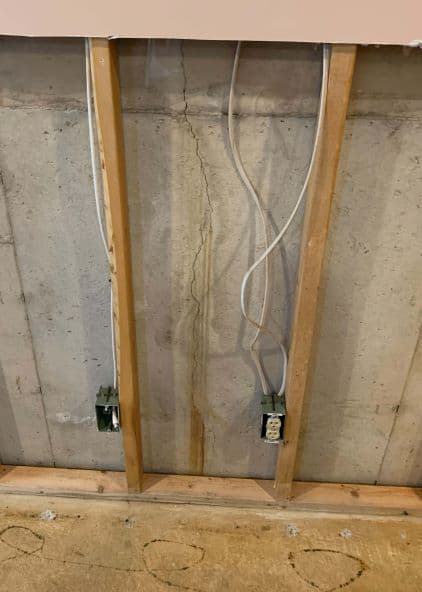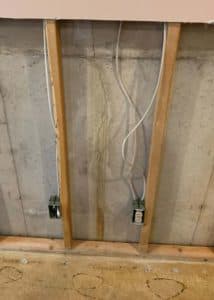
Most people assume that if their foundation has a water problem, they’ll notice it quickly. This isn’t always the case, however. Water may be damaging your foundation without leaking into your basement or crawl space. But if you see cracks in your foundation - dry or wet - this can be a sign of trouble on the horizon.
Founded in 1996, Acculevel specializes in foundation repair and waterproofing. We are a family-owned and operated company serving Indiana and parts of the surrounding states, and we want homeowners to be aware and knowledgeable about foundation warning signs. You can save a great deal of money if you catch and repair smaller problems before they become major trouble.
In this article, we’ll discuss the different ways that water damages your foundation. We’ll show you what signs and symptoms are concerns, and discuss the best repair methods to use. At the end, we also provide additional resources to help you learn more about home repairs and how to find the right contractor for you.
[box type="warning"] A warning for homeowners: your foundation is a critical piece of your home, and is not a wise or safe place for most DIY-types of repairs. Please leave foundation repairs to the experts. [/box]
There are two major ways water can damage a home’s foundation: hydrostatic pressure and erosion.
Hydrostatic pressure, put briefly, is the force that results when there is too much water in the ground. Once the soil has absorbed all it can, that excess water starts “looking” for another place to go. Your foundation is a dam, trying to hold back this water- and the collision between the two is where cracks can form.
 This photo was taken by an Acculevel project manager during a routine free estimate. This finished basement has developed a narrow crack. It couldn’t be seen by the homeowner, so it went unrepaired until it began to leak- damaging their drywall, insulation, and carpet.
This photo was taken by an Acculevel project manager during a routine free estimate. This finished basement has developed a narrow crack. It couldn’t be seen by the homeowner, so it went unrepaired until it began to leak- damaging their drywall, insulation, and carpet.
Hydrostatic pressure cracks your foundation in a consistent way. It starts with water pressing against the concrete, then slowly seeping into it (because concrete is a porous material). As the water forces its way through, small cracks form.
Cracks like these can be repaired with an epoxy fill. Epoxy will both stop the water leaking and repair the crack. Epoxy fill is a relatively inexpensive repair option, is quick to do, and should be warrantied (Acculevel guarantees their epoxy fill for 5 years).
More serious cracks can also be a result of hydrostatic pressure, although they don’t normally appear until you also have some of the smaller cracks mentioned above. This is because larger cracks generally take longer to form. These are eye-catching, and should be cause for alarm. Long horizontal cracks, or cracks between blocks that look like stairs, are a precursor to a bowing wall.
 This photo was also taken by an Acculevel project manager during a routine free estimate. The wall has developed both horizontal and stair-step cracks. It’s difficult to see from the picture, but the wall is bowing slightly inward.
This photo was also taken by an Acculevel project manager during a routine free estimate. The wall has developed both horizontal and stair-step cracks. It’s difficult to see from the picture, but the wall is bowing slightly inward.
If you see any of this type of crack, please take prompt action. A bowing wall- if left unrepaired- will eventually cave in. The most common repair method for a badly cracked or slightly bowing (less than 2 inches) is to use carbon fiber straps.
There are other repair methods, if the wall is bowing more than 2 inches. These are wall anchors, or helical tiebacks. We cover those in more detail in this article.
If you have noticed one of these symptoms, please investigate if you have the others. One of these alone could be caused by other issues- but a combination of two or more is a clear indication of settling.
All homes settle; it’s a natural function of the weight of your home applying pressure onto the ground below. But if your house doesn’t settle evenly, damage can occur.
We’ve all sat down at a table that wobbles because one leg is slightly shorter than the rest. This is kind of the same situation; if the ground beneath one section (it’s frequently a corner) of the foundation erodes or softens from too much water, your foundation will no longer be level. This is much worse for your home that is it for your wiggling table.
All of the materials used to build your house are meant to be stable and secure. They’re not flexible- concrete, iron, and wood do not have elastic properties. So when your foundation is uneven, it puts tremendous strain on your home. This is why cracks appear and openings become difficult to open or close. The framework is being twisted in a way it was not designed to do.
Unfortunately for your foundation, it will take more than a folded-up napkin wedged below your foundation to restore stability. You’re going to need something far more substantial: helical piers.
Helical piers are, in the simplest terms, steel posts that go into the earth like giant screws.

The pier is screwed into the ground next to your foundation until it reaches the necessary depth (determined by pressure gauge). Once it’s secure, it’s attached to your foundation with a steel bracket. This is what holds the foundation still, so it won’t “wobble” like a bad diner table.
You can learn more about helical piers and their costs in this post.
You should find an experienced and reputable contractor that specializes in foundation repair. Not sure how to do this?
If you live in Indiana or the surrounding areas, please contact Acculevel. One of our experienced project managers will evaluate your foundation condition and recommend the best course of action for you, to keep your home strong and healthy for years to come.
Don’t live in our service area? This article will help you find a company that services your area.
We strongly recommend that you check the Better Business Bureau before you make any decisions; the BBB will help you determine if the contractor is accredited and insured.
And please don't hesitate to use our checklist of questions you should ask a contractor before signing a contract.
If you have more questions about foundation repair, we have a thorough guide that explains all of the concepts in this article- in far greater detail. Feel free to read just the sections that interest you, the entire guide, or even bookmark it for future use!
[DISPLAY_ULTIMATE_SOCIAL_ICONS]